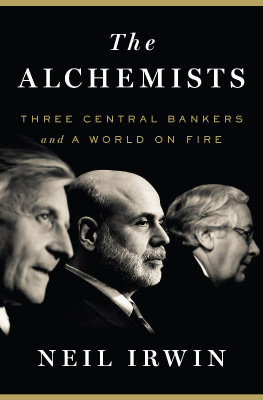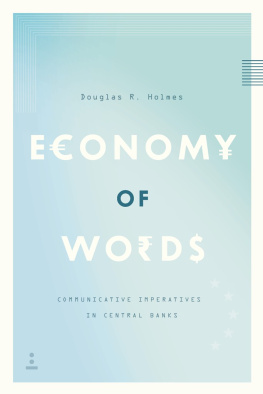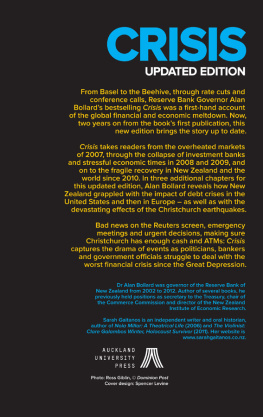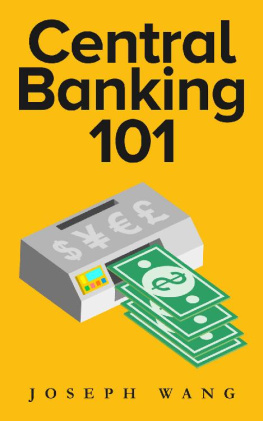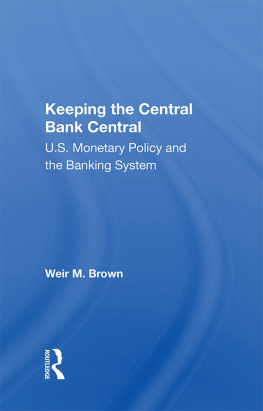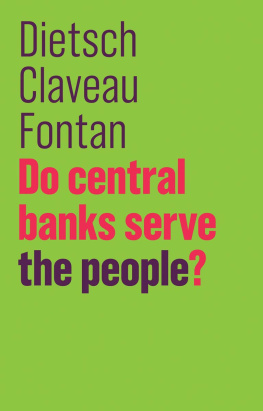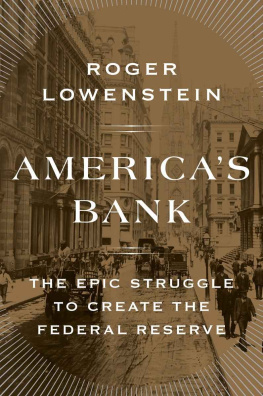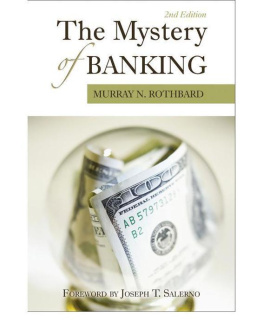All rights reserved. No part of this book may be reproduced, scanned, or distributed in any printed or electronic form without permission. Please do not participate in or encourage piracy of copyrighted materials in violation of the authors rights. Purchase only authorized editions.
Photograph credits appear .
Time Line
November 30, 1656Johan Palmstruchs Stockholms Banco is chartered by Swedish king Karl X Gustav.
1661Stockholms Banco issues the first paper banknotes in Europe.
September 17, 1668After Stockholms Banco collapses, the Swedish Riksbank is created. It remains the countrys central bank until this day.
July 27, 1694King William III charters the Bank of England.
May 10, 1866British bank Overend, Gurney & Co. fails, sparking a panic in the London money markets. The Bank of England floods the banking system with liquidity, acting as lender of last resort.
Fall, 1907A banking panic in New York sparks a global economic downturn, crystallizing the need for a central bank in the United States.
December 23, 1913The Federal Reserve Act passes, setting up a central bank for the United States, albeit one with a complicated structure of twelve powerful regional branches.
1923The German Reichsbank, led by Rudolf von Havenstein, prints massive amounts of money, resulting in hyperinflation. Price increases of thousands of percent per month destabilize the war-ravaged nation and spark uprisings by the Nazis and other insurgent groups.
November 16, 1923Hjalmar Schacht introduces a new and more stable German currency, the rentenmark. Its value is set at one rentenmark per trillion reichsmarks.
October 29, 1929The U.S. stock market crashes on Black Tuesday.
May 11, 1931Credit-Anstalt, a leading Austrian bank, fails, prompting a ripple effect of withdrawals and more bank failures in Germany and elsewhere in Europe.
July 9, 1931Hans Luther, head of the German Reichsbank, travels to European capitals and then to meet fellow central bankers in Basel, looking in vain for international relief from the growing banking crisis.
September 21, 1931Britain leaves the gold standard, facing economic collapse should it try to maintain the peg of the pound to the price of gold.
July 22, 1944Global economic leaders finish a conference in Bretton Woods, New Hampshire, where they agree to a world economic order for the postWorld War II globe.
August 15, 1971With the United States struggling to maintain the peg of the dollar to gold as mandated by the Bretton Woods system, President Richard Nixon suspends the gold window. His advisers include Federal Reserve chairman Arthur Burns and Treasury official Paul Volcker.
1978In Arthur Burnss final year as Federal Reserve chair, inflation reaches 9 percent.
October 6, 1979In an unscheduled Saturday meeting of Fed policymakers, new chairman Paul Volcker engineers an interest rate hike and a new strategy to tighten the money supply, aiming to bring down inflation. These rate hikes lead to a deep recession, but eventually end the inflation that took root under Burns.
December 10, 1991European leaders agree to the Maastricht Treaty, pledging to create a common currency.
June 1, 1998The European Central Bank is created to administer the euro.
March 19, 2001Suffering economic stagnation in the wake of a real estate and banking system collapse, the Bank of Japan begins a program of buying assets, known as quantitative easing.
July 1, 2003Mervyn King takes office as 119th governor of the Bank of England.
November 1, 2003Jean-Claude Trichet takes office as second president of the European Central Bank.
February 1, 2006Ben Bernanke takes office as the fourteenth chairman of the Board of Governors of the Federal Reserve System.
2007
August 9BNP Paribas announces it is unable to value mortgage-related assets on the books of three funds it manages, sparking a freeze-up in money markets and a 95 billion intervention by the ECB.
September 14The Bank of England intervenes to aid Northern Rock, a British bank on the verge of failure.
December 12The Federal Reserve, Bank of England, ECB, and central banks of Canada and Switzerland announce liquidity swap lines to provide up to $24 billion to help ease a freeze-up of the banking system. The first joint international effort of the global central banks during the crisis, it is a tool to channel dollars from the Fed to European banks that are facing shortages of dollars.
2008
March 14The Fed rescues investment bank Bear Stearns by putting up $30 billion toward its acquisition by J.P. Morgan. It is the first bailout by the Fed in the crisis.
September 15Lehman Brothers files for bankruptcy.
September 16The Fed rescues insurer AIG with an $85 billion emergency loan.
September 18The Fed, ECB, and central banks of Britain, Canada, Japan, and Switzerland expand swap lines by $180 billion, a move that enables the global central banks to lend dollars into their domestic banking systems.
September 24Fed swap lines are extended to the central banks of Australia, Sweden, Denmark, and Norway.
September 29Swap lines are expanded by another $330 billion.
September 30The Irish government announces it is guaranteeing the liabilities of the nations major banks, sparking a run on banks in European nations without such guarantees.
October 7The Fed announces the Commercial Paper Funding Facility to backstop the multitrillion-dollar market for short-term corporate lending.
October 8In the first ever globally coordinated monetary policy action, the central banks of the United States, eurozone, Britain, Canada, Sweden, and Switzerland announce that they are all cutting interest rates.
October 29Fed swap lines are extended to the central banks of Brazil, Mexico, South Korea, and Singapore.
November 6Bank of England cuts target interest rate by 150 basis points.
December 16The Fed cuts its target interest rate to near zero and says it expects conditions will warrant exceptionally low rates for some time.

